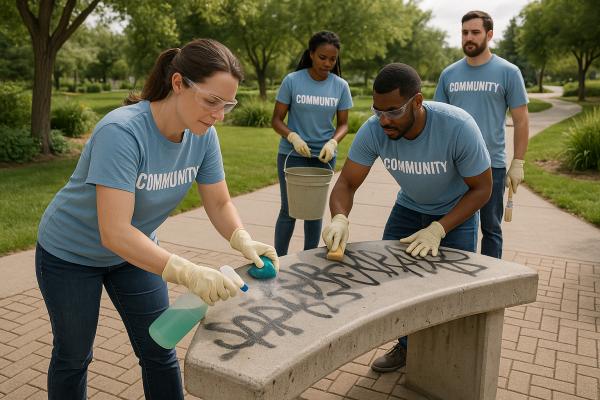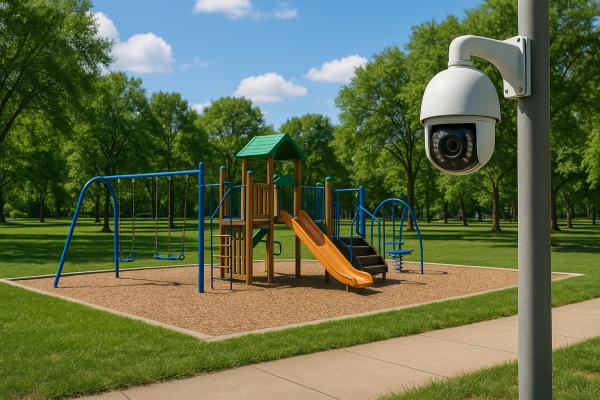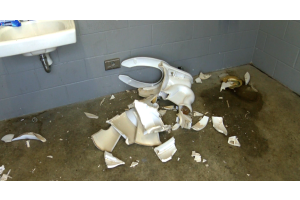Last Updated: April 18, 2025
Public parks are essential community hubs, offering spaces for recreation, nature appreciation, and social gathering for residents in places like Gilroy, CA, and nationwide. However, these valuable public assets are often targets for vandalism – from graffiti and minor damage to the costly destruction of facilities. Dealing with park vandalism drains maintenance budgets, impacts visitor safety, and detracts from the community's enjoyment. Fortunately, a proactive, multi-layered approach can significantly reduce vandalism and keep parks safe, clean, and welcoming.
Understanding the Impact of Park Vandalism
Vandalism in parks isn't just an eyesore; it carries significant consequences. Broken equipment, graffiti (like the defaced bench shown below), and damaged facilities lead to increased costs, reduced safety, negative community perception, and potential loss of access to essential facilities like restrooms.

Addressing vandalism proactively is crucial for maintaining safe, welcoming, and cost-effective public parks.
1. Implement Crime Prevention Through Environmental Design (CPTED)
CPTED principles use the physical environment to deter criminal behavior, including vandalism. By designing and managing park spaces thoughtfully, you can reduce opportunities for damage.
- Maximizing Natural Surveillance: Design spaces with clear sightlines. Avoid dense, high shrubs or solid walls that create hiding spots. Ensure playgrounds, seating areas, and restrooms are easily observable from pathways, nearby buildings, or roads. Prune lower branches of trees to maintain visibility underneath.
- Optimizing Lighting: Adequate lighting is one of the most effective deterrents for nighttime vandalism. Use energy-efficient LED lighting, ensure even coverage (avoiding deep shadows), and consider timers or motion sensors in lower-traffic areas. Focus on entrances, pathways, restrooms, and key facilities, creating a welcoming night environment as shown below.

- Strategic Landscaping: Use landscaping to guide movement and define spaces. Consider "hostile vegetation" like thorny bushes in vulnerable, non-traffic areas, but balance this with maintaining open sightlines.
- Control Access Points: Clearly define entrances and exits. Use fencing or natural barriers strategically to channel foot traffic and discourage access to sensitive areas after hours, if applicable.
- Territorial Reinforcement: Create a sense of ownership. Clear signage, well-maintained landscapes, community gardens, and distinct boundaries show that the park is cared for and actively managed, making it less attractive to vandals.
2. Prioritize Consistent Maintenance & Rapid Response
A well-maintained park sends a powerful message that the space is valued and monitored. The "broken windows theory" suggests that visible signs of disorder, like existing graffiti or damage, can encourage further negative behavior.
- Swift Graffiti Removal: Aim to remove graffiti within 24-48 hours whenever possible. Rapid removal discourages taggers seeking recognition. Using appropriate graffiti removal solutions tailored to different surfaces is key, as demonstrated by the cleanup effort shown below.

- Prompt Damage Repair: Fix broken benches, damaged signs, or malfunctioning fixtures as soon as possible. This minimizes safety hazards and reinforces that the park is actively cared for.
- Routine Cleaning & Upkeep: Regular trash removal, landscape maintenance, and cleaning of facilities contribute to a positive environment that discourages misuse.
3. Foster Community Engagement and Ownership
An engaged community becomes the park's best advocate and provides extra sets of eyes and ears.
- Encourage Positive Activities: Organize or facilitate community events, sports leagues, farmers' markets, outdoor concerts, or fitness classes. Active, positive use of the park, like children enjoying a playground, displaces potential negative behavior.

- Support Volunteer Groups: Facilitate "Friends of the Park" groups or volunteer days for cleanups, plantings, or minor repairs. This builds a strong sense of community stewardship.
- Visible Communication: Post park rules clearly, including specific prohibitions against vandalism and potential consequences. Ensure contact information for reporting issues is readily available.
- Involve Youth: Engage local schools or youth groups in positive park projects, like creating murals (in designated areas), planting gardens, or participating in cleanup events to foster respect for the space.
4. Invest in Durable, Vandal-Resistant Infrastructure
While design and community efforts are crucial, the physical infrastructure must be able to withstand potential abuse, especially in unmonitored or high-traffic areas like restrooms. Standard fixtures, like the broken dispenser below, often require frequent, costly replacement.

Choosing fixtures and furnishings made from robust materials with tamper-resistant designs is a critical layer of defense. Look for heavy-gauge stainless steel, concrete, polycarbonate, robust locking mechanisms, and tamper-resistant fasteners.
Specialized manufacturers, like Vandal Stop Products, focus on engineering solutions specifically for these challenges. Investing in purpose-built items significantly reduces the frequency of repairs and replacements:
- Secure Restrooms: Utilize vandal-resistant toilet paper holders, soap dispensers, paper towel dispensers, and shatterproof mirrors designed to prevent prying, impacts, and tampering.
- Protect Utilities: Secure vital components with heavy-duty lock boxes for electrical panels, irrigation timers, and outlets (locking covers).
- Durable Furnishings: Ensure waste receptacles and site furnishings can withstand abuse and weather.
- Safety Considerations: Provide secure sharps containers where needed.
While potentially having a higher initial cost, these durable solutions offer a much lower total cost of ownership over time by drastically cutting down on replacement cycles and associated labor costs. (You can explore a detailed cost analysis here - *[Link to the separate cost-savings page when created]*).
5. Implement Effective Surveillance and Reporting
Monitoring can act as a deterrent and assist in identifying offenders when incidents occur.
- Visible Security Presence: Regular but varied patrols by park staff, rangers, or local law enforcement can discourage illicit activities.
- Strategic Camera Placement: If using CCTV, focus on key entry/exit points, high-value assets, and known problem areas like playgrounds or restrooms. Ensure good lighting for nighttime clarity. Be mindful of privacy regulations and post clear signage indicating surveillance is in use.

- Accessible Reporting System: Make it simple for park staff and the public to report vandalism or suspicious activity immediately via phone, a dedicated app, or an online form on the park's website. Prompt reporting enables a quicker response.
Conclusion: A Layered Approach for Lasting Results
Preventing vandalism in public parks requires more than just reacting to incidents. A successful strategy integrates thoughtful design (CPTED), vigilant maintenance, strong community partnerships, appropriate surveillance, and crucially, investment in durable infrastructure designed to withstand challenging public environments. By implementing these layered approaches, communities like Gilroy and others can protect their valuable park assets, reduce long-term costs, and ensure these spaces remain safe and welcoming for all residents.
Need Help Fortifying Your Park Facilities?
If persistent vandalism is impacting your park's budget and usability, explore solutions designed for durability. Vandal Stop Products offers a wide range of heavy-duty, tamper-resistant fixtures built to last in public environments.
Explore Vandal-Resistant Solutions Ask a Specialist Request a Quote





